Saving Mollem: bringing sustainable tourism to the Western Ghats
- Luke Sequeira

- Jun 24, 2020
- 8 min read
Updated: Sep 21, 2020
By Aishwarya Shah
In classic 2020 style, yet another blow has been dealt to the citizens of Goa as the state furtively cleared three projects that will undoubtedly rupture the socio-ecological integrity of Mollem National Park and Bhagwan Mahaveer Wildlife Sanctuary. The projects include four-laning the existing NH-4A highway, and laying a 400KV transmission line, and the proposed doubling of a railway line, all of which cut through protected areas.
The estimated loss of forest cover is about 250 hectares, razing 59,000 trees to the ground and cutting through tiger habitats as well as that of several other wildlife species.
The gravity of the impact should imply that the government spent weeks, even months in talks, discussions and debates, going over every other alternative to the proposed ecocide.
However, the Goa State Wildlife Board, which convened in person in December after a year long hibernation, entered into the mechanics of this decision in less than an hour.
Needless to say that when the lives of 21 plant species, 235 bird species, 219 butterfly species, 80 odonate species, 70 mammal species, 75 ant species, 45 reptile species, 44 fish species, 43 fungi species, 27 amphibian species, 24 orchid species, and 18 species of lichens hang in the balance, the very least the Environment Minister Prakash Javadekar could do is hold off until the situation permits a round table discussion where facts, figures and blueprints can be compared.
Offering no hope of redemption, only an afforestation plan that makes bizarre suggestions such as planting bougainvillea along highways instead of canopy cover to counter the effects, the government’s offhand way of arriving at the decision is almost as worrisome as the enormity of its impact. A decision that, from the manner it was arrived at, seems to serve only larger corporate interests from outside the state.
This could very well be the make or break factor in how Goa relates to sustainable tourism. More so, in the wake of the economic slump caused by the pandemic and a global acceptance of the need to build a more sustainable economy.
Sustainable tourism in Goa
What does this mean for tourism in Goa? The pandemic has given a broader platform to the voices in the tourism industry as they rally together to support various communities in need. Conversations around sustainability and self sufficiency have gained impetus throughout the state with the destruction of supply chains leading to the awareness of how vulnerable the tiny coastal state is to global phenomena like pandemics and failing economies. Tourism has been one of the largest industries in Goa for decades and there is an ever growing pool of actionaries trying to implement sustainable tourism in the state. In order to maintain the revenue generated by the industry, a model has to be adopted that assures a sustainable and continued growth of the sector.
Goa is in a unique position to emerge as the leader of sustainable tourism in the Western Ghats as all the pieces of the puzzle can be found here:
Strong demand for tourism
Breathtaking natural wonders ranging from waterfalls & jungles to beaches & mountainscapes
An invested scientific community
A vocal and powerful network of sustainable tourism operators who care
A local populace that has been critical about tourism’s impact on their state
And endless investors who want to cash in on Goa’s evergreen tourism economy
Piloting a values-driven project in the Western Ghats
Let’s say the pieces of the puzzle were to come together. What would it take for the vision of sustainable tourism to yield a reality that is viable economically, ecologically and socially?
One way is for the government of Goa is to recognise the myriad ways in which the Western Ghats protect Goa:
The carbon soaking capacity of 59,000 full grown trees, the heterogeneous jungle habitats populated by various species that keep the ecosystem safe from the spread of a single type of virus or vector, the mangrove forests that protect the coast from storm surges and so on. The immense biodiversity within the ecosystem frames life as we know it in the state, from our understanding of seasons, temperature, monsoon cycles and so on.
Photos by @techforwildlife, @paragrangnekar, @pixelpencils_1021, @rohan_r9 & @_.ennayl._
via #magicalmollem on Instagram
How can we safeguard this intricate network?
Presently there are several small projects in the forms of farms, homestays, adventure activities that bring tourists into the fray of Goan wilderness. These projects also work closely with indigenous tribes, offer alternative livelihoods to displaced miners and employ a whole systems approach when it comes to their use of the land. However, these projects, although impact-driven and inspiring, are small in scale and scope due to limited financial resources.
What Goa needs is bigger investments which would coalesce the needs of the stakeholders and offer an economic avenue towards manifesting a project that is built around the concept of sustainability.
A pilot project of small to medium scale in the Goan leg of the Western Ghats could be the new lease on life that the industry is looking for. If such a project is to succeed, then several similar projects can be built up in various segments of the jungles and hinterlands. A format of exploring the region whilst assisting indigenous livelihoods - this has to be the future of tourism in Goa!
Omkar Dharwadkar from Mrugaya Xpeditions adds an important caveat in saying that: “the carrying capacity of a particular place needs to be studied so as not to burden the natural resources available there as well as the local community” - a crucial factor when we look at the overburdened villages along the coast of North Goa that are bursting at the seams.
For sustainable tourism in the Western Ghats to flourish, there has to be an assessment of its rich hinterlands, in terms of what level of engagement benefits a community.
A ceiling ought to be put in place to avoid their exploitation, and greater research is needed to know what the ceiling in this specific context needs to be. Beyond a certain threshold, even the best intentions turn out to have a harmful impact on the native population as no delicate ecosystem can withstand a sudden increase in pressure on resources which uncontrolled tourism is bound to bring.
Creating something unique and financially rewarding takes long term planning and resources, both of which the state government refuses to offer.
It is undeniable that the tourism sector needs to diversify in order to remain resilient to the changing tides of demand, which are increasingly subject to the unpredictable effects of climate change and ecological collapse. Further, it is tautological to continue to invest in a saturated sector with more resorts and more casinos and more egregious tours. Increasingly so, Goa has begun to attract a new wave of tourists who wish to experience the vast and unending beauty of Goa’s wilderness. Hinterland tourism occurs throughout the year, unlike coastal tourism, and this could ensure the livelihoods of a larger group of people.
The demand exists, we just need bigger players with a values driven approach to be able to plant Goa firmly in the sustainable tourism circuit globally.
Learning from the global sustainability circuit
The development of sustainable belts in several tourism hotspots worldover has been spurred by one of two factors: investments from conscious players or staid government intervention, Ideally both, but that is not often the case. For example, the pioneers of tourism in North West Bali harnessed their location next to a protected national park and the coastline to build a brand of ecotourism in the region. The youth in these villages benefit from the existence of a long term plan which takes several steps to inculcate the right values and habits in their citizenry from an early age.
Goa could do the same - there are a large number of people that have to leave the state for work, are forced to work hard jobs in mines or emigrate if they have the means, largely because their home state is unable to dynamically offer them viable alternatives.
With the proper level of training, they could find meaningful livelihoods in heritage tours, forest guides and other forms of community tourism.
As Pooja Bhatia from Khoj-aao noted, “they [Goa’s youth] are the biggest resource the state has, so the way to increase local employment and equity is to keep the focus on the community.”
Student works via the @mollem.memory.project Instagram page
With the current model of tourism as the default setting, tourism will soon wipe out every traditional livelihood remaining in the state. Nature-based tourism has been on the rise worldover and in regions like Southern Africa, it boasts a revenue equal to that of farming, forestry and fisheries combined.
Costa Rica, similar to Goa in terms of size, climate and footfall of tourists, has proved to the world that developing your USP around sustainability is the most pragmatic strategy a destination can adopt. The Costa Rica Tourism Board (ICT) has developed a myriad programs helping certify, protect and award the sustainable tourism industry within the country, including a certification in sustainable tourism. The strong involvement of top civic bodies and their unwavering support makes the transition much easier.
Fact is that there is a global movement towards sustainable tourism.
Several destinations have shown us that it is entirely feasible to develop an alternate model that ties together people, planet and profit. Goa is perfectly poised to be able to optimise the growing momentum and steer its way into a new paradigm swiftly, but this is hardly conceivable with the state offering its support to a haphazard destruction of the very natural hotspots that would make this shift possible.
Where does Goa go from here?
From a tourism perspective, the most crucial fight right now is to save Mollem.
The projects proposed are likely to lead to more such ones that will irrevocably destroy what remains of the once-abundant biodiversity. Various members from the tourism industry have banded together to bolster the campaign against these projects. Beyond the campaign, it is crucial that we come together to collate a vision for sustainable tourism in Goa. The Western Ghats are a UNESCO certified biodiversity hotspot, home to tigers and Malabar pied hornbills and hundreds of astounding species. If we do not find a way to protect them in a permanent way, more such projects and proposals will be pushed through spuriously.
The immediate task at hand is to support the campaign to save Mollem. There is a petition that is almost at its target of 75,000 signatures that you can support and share.
You can write an open letter from your community to the state government - whether you represent students, nature lovers, senior citizens, your church or your university! The more traction the movement gets, the more pressure can be put on the government to reverse their decision. Engage with the people around you, share your memories of Mollem, keep the conversation alive. Take to the streets if it comes to that, the power of protest in the present day is undeniable.
Most importantly, do not lose hope. We are at the precipice of the most pervasive paradigm shift in recent history.
Artworks by @spica.elpea.artist, @airphish, @inkings7, @inherownspace & @pearl.dsouza
via #virtualwipeout on Instagram
Localised movements across the globe have shown the power of a united, determined citizenry. This campaign is supported by leading scientists, lawyers, activists both within and without the state. Over 6000 emails have been sent to the state, countless original artworks have been created for Mollem, Instagram pages have been documenting the connection of individuals to Mollem, ecologists are doing educational webinars and the media has been responsive to the movement.
No matter what happens next, this is a decisive step forward.
It’s time to stand up for what we stand on!
We want to give a huge thank you to our writer, Aishwarya Shah, for compiling this incredibly important piece and bringing the #SaveMollem story to the Goa.me community.
We also want to thank Nandini Velho, Pooja Bhatia, Francesca Cotta, Gabriella D'Cruz & Nitish Fatarpekar for their valued inputs & contributions to this article.
To learn more, we highly encourage you to click through the links provided in this article, to follow the suggested Instagram pages & hashtags, to check out @mymollem.goa's press kit, art & social media kits and most importantly to ask questions amongst your community and keep this conversation going.
For further reading & listening, be sure to check out:






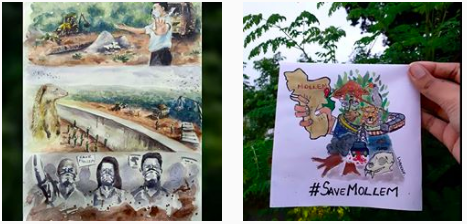

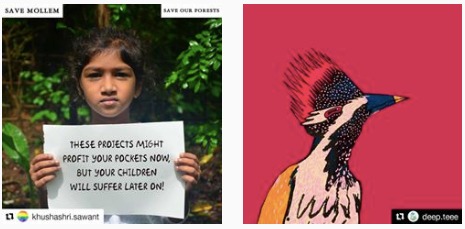



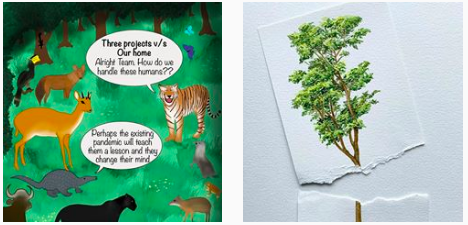

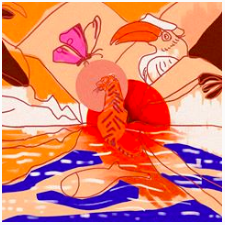

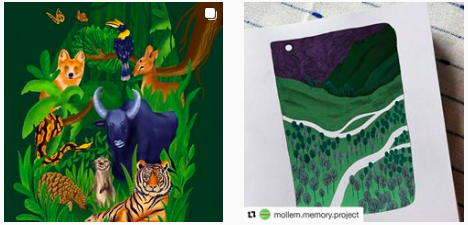




Comments